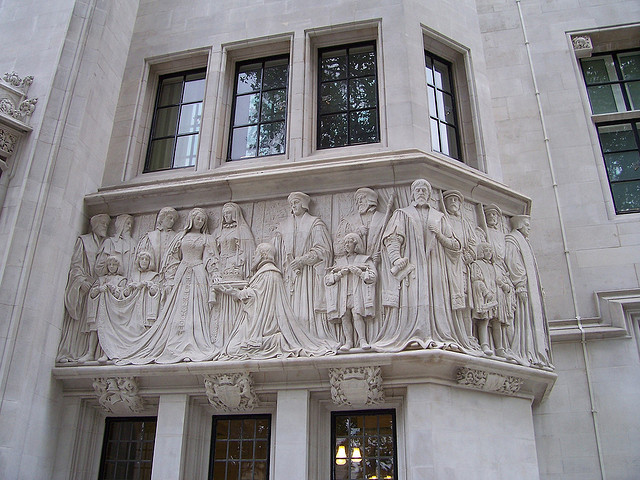The growing body of ‘right to die’ case law illustrates the issue’s growing prominence
The legal position of those who wish to end their own lives with assistance from another person has been consistently ambiguous, with politicians unable to come to a unified position, and the courts reluctant to take the initiative. Claire Overman takes a look back over the legal system’s attempts to deal with the issue, observing that the amount of accumulated law now on the statute book reflects a growing public awareness of the issues at stake.
On 25th June, the UK Supreme Court handed down judgment in the cases of Tony Nicklinson, Paul Lamb, and a party known simply as Martin. It held that it would not make a declaration of incompatibility between the present prohibition on assisted suicide, and Article 8 of the European Convention on Human Rights, which protects a person’s private life.
The applicants in these joined cases suffered from debilitating medical conditions, and wished to end their lives. However, they were unable to do so themselves, and they would therefore require assistance. As the law presently stands, under Section 2 of the Suicide Act 1961, it is a criminal offence to do “an act capable of encouraging or assisting the suicide or attempted suicide of another person,” with the intent of so encouraging or assisting them.
This decision represents merely part of a series of cases which have had to grapple with the difficult issue of the circumstances in which a person’s life may lawfully be ended. The first of these high-profile cases was Airedale NHS Trust v Bland, decided in 1993. In that case, a victim of the Hillsborough Disaster had been in a permanent vegetative state for almost four years. The House of Lords held that it was lawful for doctors to discontinue the medical treatment of a person in such a state. The touchstone was whether it was in the patient’s “best interests” for treatment to be withdrawn, and the court also acknowledged that an individual (of sound mind) was, in law, able to refuse treatment in advance.
The court in Bland characterised the turning off of the patient’s life support machine as an omission; a withdrawal of treatment. However, as acknowledged in Nicklinson and Ors, the case of In Re A (Children) (Conjoined Twins: Surgical Separation), “the law took a step further.” The Court of Appeal in that case permitted the surgical separation of conjoined twins, the weaker of whom was kept alive by the stronger. This was permitted even though this would inevitably lead to the death of the weaker twin, on the basis that if they remained joined then both would die within 3-6 months.
However, despite the lengths to which the courts have gone in these cases, there appears to have been a more restrictive approach adopted in cases which have looked specifically at assisted suicide. As mentioned above, the present prohibition on assisted suicide has been in force since 1961, and attempts have been made to challenge its compatibility with various rights under the European Convention on Human Rights, including the right to life (Article 2), the right to be free from inhuman and degrading treatment (Article 3) and the right to a private life (Article 8).
In R (Pretty) v Director of Public Prosecutions, the House of Lords held that these rights of the appellant, who suffered from motor neurone disease, were not engaged by the prohibition. She applied to the European Court of Human Rights, which held that her Article 8 right was engaged. However, interference with this right may be justified in the circumstances listed in Article 8(2). In Pretty v UK, the European Court held that it was the “vulnerability of the class which provides the rationale for the law in question,” and that “clear risks of abuse do exist.” It further held that a blanket ban – permitting no exceptions or exercise of discretion – was not disproportionate.
However, it is not entirely accurate to say that that the 1961 Act imposes a blanket ban on assisted suicide. In cases of criminal prosecutions, the Crown Prosecution Service, headed by the Director of Public Prosecutions, must determine whether prosecution is in the public interest. It therefore follows that there may be cases where prosecution for assisted suicide is held not to be in the public interest. Accordingly, in the case of R (Purdy) v Director of Public Prosecutions, the House of Lords held that, in the context of assisted suicide, the DPP was required to;
“…promulgate an offence-specific policy identifying the facts and circumstances which he will take into account in deciding…whether or not to consent to a prosecution.” The Supreme Court, in this most recent case, has held this policy to be sufficiently clear and detailed.
What, then, are the types of arguments advanced in these cases? On the one hand, there are arguments that life is sacred, and that any taking of life, no matter how benevolently-motivated, must be criminalised. A related argument is that the authorisation of assisted suicide may mark the beginning of a slippery slope, towards a situation where those with terminal illnesses are made to feel like a burden, or are even actively encouraged to end their lives.
However, these arguments are balanced against the principle of autonomy – that an individual should be free to determine the manner and time of death. Interestingly, an argument on the basis of discrimination was raised by the applicant in Pretty. She argued that an able-bodied person was able to commit suicide without fear of adverse consequences, but an individual with a disability rendering it impossible to commit suicide alone was prevented from being assisted.
The Supreme Court’s most recent judgment, which concentrated largely on the institutional question of whether it should be courts that deal with these questions only fleetingly engages with them itself. But it is clear from the growing body of case law that these questions are becoming more prominent in the public consciousness. The Church of England has recently called for an inquiry into the matter, and a former Archbishop of Canterbury has come out in support of assisted dying. Such an inquiry would allow these issues, which lie at the difficult interface between law and morality, to be fully explored.
—
Note: this post represents the views of the author and not those of Democratic Audit or the LSE. Please read our comments policy before posting. The shortened URL for this post is: https://buff.ly/1maH4pW
—
 Claire Overman is a BPTC student at Kaplan Law School, having studied for a BA and BCL at the University of Oxford and the Université de Paris. She is the Editor of Oxford Human Rights Hub blog.
Claire Overman is a BPTC student at Kaplan Law School, having studied for a BA and BCL at the University of Oxford and the Université de Paris. She is the Editor of Oxford Human Rights Hub blog.






 Democratic Audit's core funding is provided by the Joseph Rowntree Charitable Trust. Additional funding is provided by the London School of Economics.
Democratic Audit's core funding is provided by the Joseph Rowntree Charitable Trust. Additional funding is provided by the London School of Economics.
The growing body of ‘right to die’ case law illustrates the issue’s growing prominence in the UK https://t.co/GcFJwOvqIu
The growing body of ‘right to die’ case law illustrates the issue’s growing prominence https://t.co/7dzIX1vT9q
A brief look at the history of the right to die before the English courts https://t.co/LuTeHJYlor
The growing body of ‘right to die’ case law illustrates the issue’s growing prominence https://t.co/uPR50hUzcP
The growing body of ‘right to die’ case law illustrates the issues growing prominence https://t.co/hlql4OYHql
The growing body of ‘right to die’ case law illustrates the growing prominence of the issue https://t.co/ByxZs3GHUB